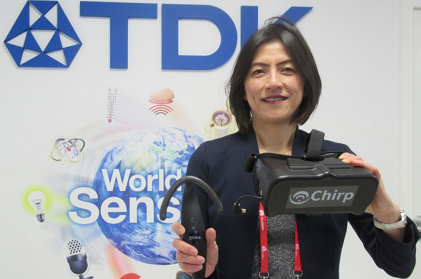MWC: Chirp Acquired by TDK
Article By : Junko Yoshida, EE Times

The sonar-on-chip startup to live in the same ecosystem with InvenSense
BARCELONA — Chirp Microsystems, a Berkeley, California-based startup with 15 employees, which launched only a year ago at the Mobile World Congress its first high-accuracy, ultra-low-power ultrasonic sensing development platform, returned to Barcelona this week with a deal in hand to be acquired by Japan’s TDK Corp.
TDK’s Board of Directors approved the transaction on Feb. 28, and the closing is expected in the following days.
Chirp is hopeful that the deal with TDK will create an opportunity for the startup team to accelerate the growth of its ultrasound technology across several markets ranging from automotive and IoT to home and mobile devices.
TDK is not revealing how much it’s paying for Chirp, mainly because the deal is small beer for a company whose revenue last year exceeded $10 billion.

In an exclusive interview with EE Times, Michelle Kiang, Chirp’s CEO, told us, “Of course, we founded Chirp, not to sell, but to grow our own business. But last fall, when we were raising money for our series A — which was oversubscribed — we also heard of TDK’s interest.” She added, “We were open to the idea of becoming a part of a larger organization because the opportunity appears to give us the chance to live in the same ecosystem they are already in, and it could become a way for us to scale our business at a much faster pace.”
TDK, founded in 1935, might be Japan’s best-kept secret among global electronics companies. Its best-known products, at least among consumers, are like magnetic tapes and magnetic heads.
However, the Japanese company, which started out commercializing ferrite, has been methodically expanding in recent years, especially in the field of sensors. Most notably, TDK pulled off the acquisition of InvenSense, a $1.3 billion deal completed last May. Now a part of the TDK group, InvenSense, headed by Behrooz Abdi, has a technology portfolio consisting of Motion, Sound, and FingerPrint.
As part of TDK’s MEMS Sensors Business Group, Chirp will become a fourth business unit focused on Ultrasonic Tracking and RangeFinding. Under the agreement, not just Chirp’s technology but its entire staff of 15 will move to TDK and must stay there for at least several years.
Move over, IR sensors?
Chirp’s ultrasonic sensors, which combine a MEMS ultrasonic transducer and a low-power mixed-signal SoC, offer a clear advantage in size compared to existing ultrasound sensors.

Speaking of Chirp’s technology, Kiang explained, “Its size, cost, extremely low power consumption, and the fact that it works under any lighting conditions, including direct sunlight, will be a huge advantage when used in mobile products.”
Aside from being used as a proximity sensor, Chirp’s ultrasonic chip poses its greatest promise as part of “an all-glass, full-screen, no-bezel display” in smartphones, Kiang previously told us. For example, she explained, “Chirp’s CH-101’s wide field-of-view allows it to measure range even when it is mounted on the top or bottom sides of the phone. Since this is the location of the microphone and speakers, it’s easy for designers to add another acoustic sensor at these locations.”
In other words, Chirp could add its sonar-on-chip to the intensifying ToF battle in smartphones.
Divi Gupta, vice president and general manager for Ultrasonic Tracking and Range Finding, was the man who talked TDK into acquiring Chirp. Kiang will be reporting to Gupta. He said that TDK’s expertise in materials, such as piezo and aluminum electrolytic, could help enhance the distance that Chirp’s ultrasound chip can reach.

It is believed that Chirp’s ultrasonic sensor technology is complementary to TDK’s ultrasonic fingerprint sensor products and the company’s other conventional piezoelectric transducer products.
Chirp can also leverage TDK’s packaging technology for small and highly robust MEMS acoustic products.
Chirp’s sensors are further likely to find synergy with TDK’s inertial sensors and sensor fusion software libraries. For example, in VR/AR applications, Chirp’s 6-DOF controller tracking solution uses a sensor fusion algorithm to link ultrasonic ToF data with inertial sensor outputs to provide 6-DOF position and orientation in handheld controllers, said the two companies. “Combining Chirp’s ultrasonic sensing expertise with InvenSense’s expertise in inertial sensing and sensor fusion algorithms, we aim to significantly enhance this AR/VR system solution.”
Currently, Chirp’s piezoelectric MEMS ultrasonic transducers offer long-range and low-power sensing in a micro-scale package. These products are being pitched for design into VR/AR, mobile, wearables, robotics, and drones. They can also be used in occupancy detection.
David Almoslino, senior director, corporate marketing of MEMS Sensor Group within TDK, also added: “Chirp will be able to take advantage of TDK’s built-in distribution and channels to sell its products wider and deeper.”
Subscribe to Newsletter
Test Qr code text s ss


